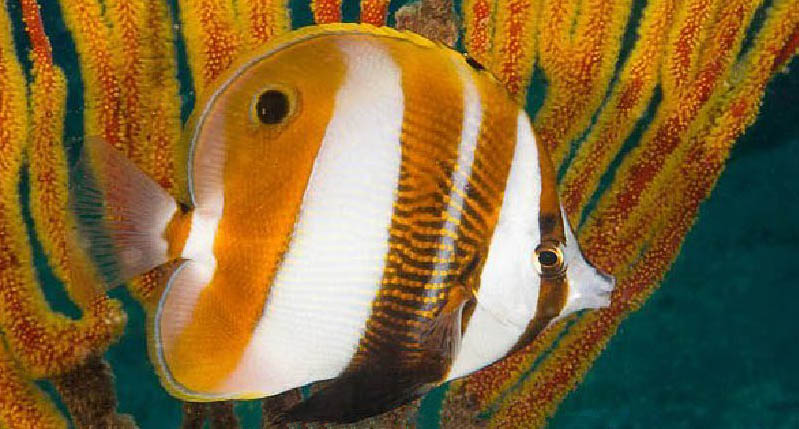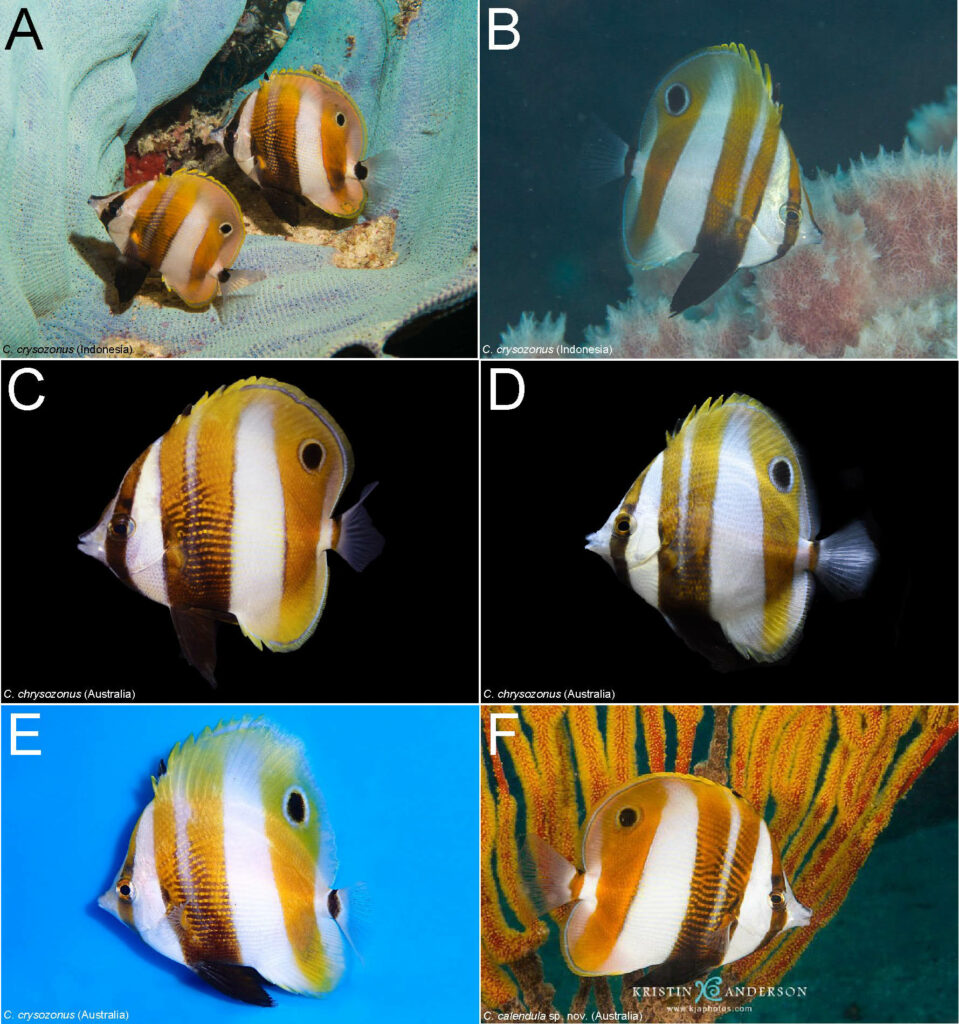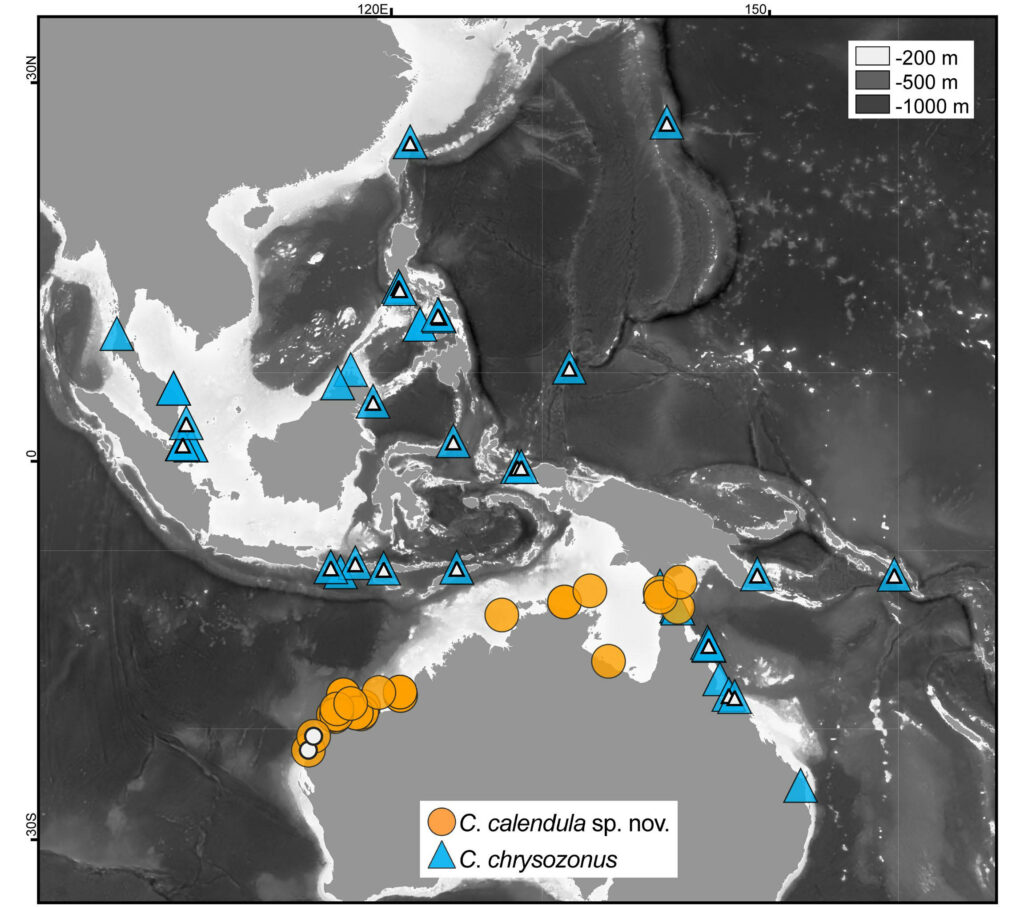
Despite centuries of exploration and study, the waters of Australia continue to reveal secrets, providing science—and aquarists—with new discoveries and previously undocumented species. The reefs of the western and northern coasts of Australia, it turns out, are home to a charismaticspecies of butterflyfish that, while certainly known to exist, had not been formally recognized as distinct until now.

“Coradion calendula, a new butterflyfish from Australia (Teleostei: Chaetodontidae),” is a new species description recently published in the Journal of the Ocean Science Foundation by Mizuki Matsunuma et al. The full, open-access article is available for reading and downloading without charge.
The new species, C. calendula, is most easily differentiated from its more well-known relative, C. chrysozonus, on the basis of the coloration of the caudal peduncle band (at the base of the tail). The new species sports an orange band, while the already-known species has a black band.

There is obviously much more underpinning the description of the new species, beyond a small color variation; other coloration differences, a different shape to the pelvic fins, geographically distinct ranges (save for one region of sympatric occurrence), and distinctive genetic lineages, all solidify the designation of the new species.

This new species may be primarily thought of as a deeper-dwelling fish, with all the specimens used for the description being collected via bottom trawls and most coming from waters deeper than 34 meters (112 feet), although the authors report that photographic evidence of a juvenile in shallow waters at the North West Cape, Western Australia.
Side note: this area is also home to the elongated, “Australian Black Clark’s Clownfish” that, while lacking scientific recognition, some have taken to calling Amphiprion milli in the aquarium hobby, resurrecting a name from an 1831 description by French naturalist Jean Baptiste Bory de Saint-Vincent. So, in the spirit of promoting “biotope-appropriate” collections, Coradion calendula would make a great butterflyfish to house with your Australian Black Clark’s Clownfishes!
The new species is given the name calendula, borrowed from the flower genus Calendula (sometimes called pot marigolds), bestowed specifically to draw attention to the yellow-orange caudal peduncle band that distinguishes the species. While the species has no trade name or common name officially proposed, the “Marigold Butterflyfish” or “Marigold Coralfish” might be reasonably suitable.
Coradion Butterflyfishes In the Aquarium
Butterflyfishes from the genus Coradion, sometimes shorthanded as “Coralfishes”, are rather uncommon in the aquarium trade and are visually reminiscent of the popular Copperband Butterflyfish (Chelmon rostratus), and the lesser-known Mueller’s Butterflyfish (Chelmon muelleri) but without the extremely elongated mouth.
As the late Bob Fenner put it on Wet Web Media, “There are three species of Coradion rarely making their way into the trade in the west. This lack of participation is mostly a matter of what I call the ‘founder effect’: Because there is no present demand, these fishes aren’t collected, and therefore there’s little awareness of them, and hence little to no demand… and around and around.”
Most Coradion butterflyfishes intentionally offered in the trade at this time seem to originate from Australia, usually with a price tag in the vicinity of $300 USD, and C. altevelis seems to be the most frequently encountered species. Interestingly, a quick look around trade websites suggests that the new species. C. calendula, has already entered the aquarium trade when it was considered to be C. chrysozonus, as clearly seen in the photos on DeJong Marinelife’s website.
Despite their low profile in the trade, these butterflyfishes generally make decent aquarium inhabitants if healthy specimens can be obtained. Author Scott Michael uses words like “hardy” and “durable” to describe members of the genus. The general recommendation of seeking specimens that are neither too young and small (and thus frail and unforgiving), nor too old and large (and stodgily stuck in their ways), continues to be the oft-repeated wisdom. So, look for moderately-sized specimens.
The paper’s authors will willing to speculate on the diet of Coradion calendula, noting that “Individuals of C. chrysozonus feed on sponge tissue and benthic invertebrates (Nagelkerken et al. 2009). Since no differences in dentition were apparent between the two species, C. calendula likely has a similar dietary habit.”
This translates to an added bonus, as these butterflies are generally regarded as somewhat reef safe in the aquarium; corals are not on their primary menu, although as with any butterflyfish in a reef, you’re taking a calculated risk. The upside of the gamble; how many Coradion butterflyfishes have you seen in a reef tank? If the opportunity presents itself, a healthy specimen from any of the species, particularly if coming from a quality supply chain like Australia, may present the opportunity to showcase a fish that’s outwardly very uncommon and eye-catching, yet isn’t going to set you back thousands of dollars to obtain!
If you already keep a Coradion butterflyfish, perhaps give it another, closer look. Perhaps you’ve been keeping this new species all along, and just didn’t know it!
References
Fenner, Bob. “Butterflyfishes of the Genus Coradion: The Genus Coradion, Coralfish Butterflies.” Wet Wet Media. http://www.wetwebmedia.com/coradion.htm
Matsunuma, M., Matsumoto, T., Motomura, H., Seah, Y.G. & Jaafar, T.N.A.M. (2023) Coradion calendula, a new butterflyfish from Australia (Teleostei: Chaetodontidae). Journal of the Ocean Science Foundation, 40, 1-285. https://doi.org/10.5281/zenodo.7504828




